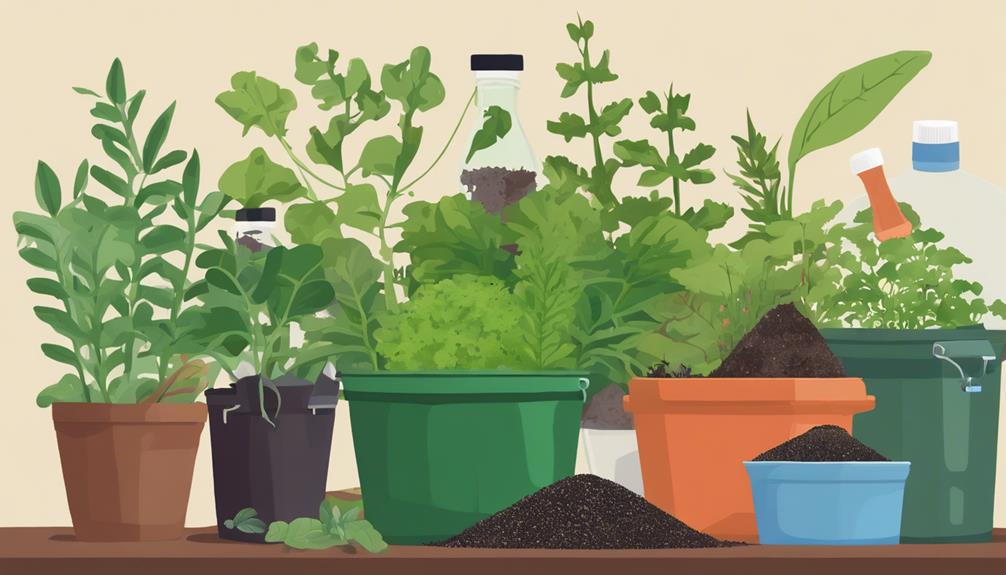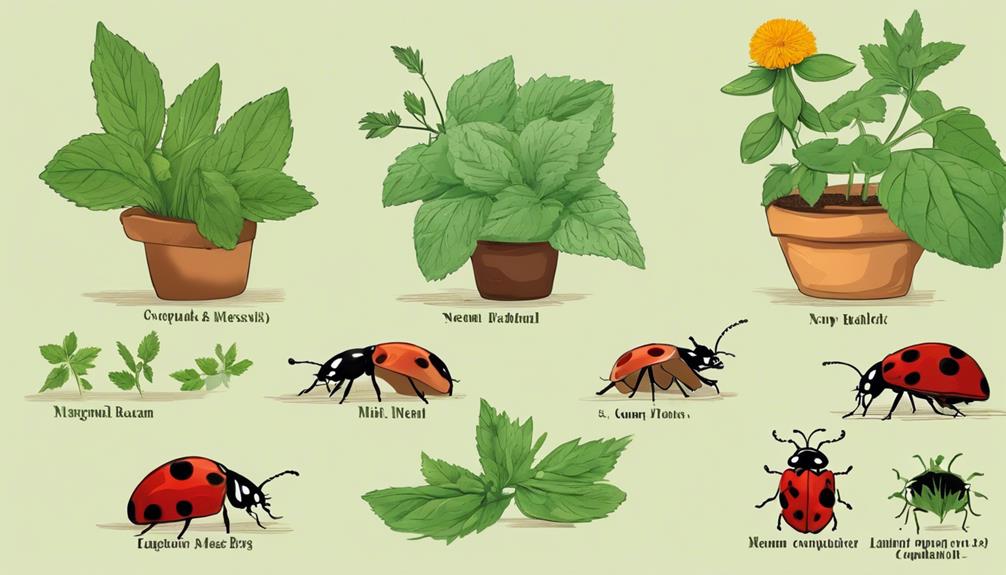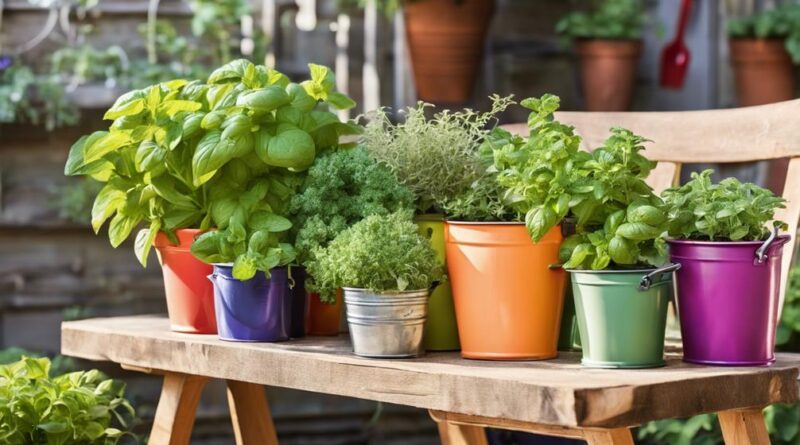10 Best Ideas for Container Herb Gardening
This post may contain affiliate links which means I may receive a commission for purchases made through links. As an Amazon Associate, I earn from qualifying purchases. Learn more on my Private Policy page.
Enhance your herb garden by choosing 12-inch containers with proper drainage. Opt for terracotta for airflow, plastic for moisture, or wood for insulation. Select basil, chives, rosemary, mint, and parsley for their sunlight needs. Use well-draining soil with peat moss and compost. Get creative with tin cans, mason jars, or hanging baskets. Bring in ladybugs with dill for natural pest control. Harvest in the morning and prune for new growth. Winterize with insulation, mulch, and adjusted watering routines. Elevate your herb garden with these ideas to maximize your harvest potential.
Choosing the Right Containers
When selecting containers for your herb garden, opt for ones that are at least 12 inches in diameter to allow ample space for root growth. Container material options vary, each with its own set of pros and cons.
Terracotta pots, for example, are classic and porous, allowing good airflow to the roots, but they can dry out quickly. Plastic containers are lightweight and retain moisture well, but they may not be as aesthetically pleasing. Wooden containers offer good insulation for roots, but they can deteriorate over time due to moisture exposure. Consider these factors when choosing the material for your herb garden containers.
Size considerations for containers are crucial to the health and growth of your herbs. Small containers can restrict root growth and lead to stunted plants, so it's best to opt for larger containers whenever possible. In containers less than 12 inches in diameter, herbs might become root-bound, affecting their overall health.
Additionally, larger containers provide more soil volume, which helps regulate soil moisture levels and temperature fluctuations. Ensure your containers have drainage holes to prevent waterlogging, which can cause root rot. By selecting containers that are the right size and material for your herb garden, you set a solid foundation for your plants to thrive.
Selecting the Best Herbs
To create a thriving container herb garden, carefully select the best herbs suited to your growing conditions and culinary preferences. When choosing herbs for your container garden, consider herb pairing and culinary uses to maximize both flavor and growth.
Basil is a versatile herb that pairs well with tomatoes, making it ideal for a container garden if you love cooking Italian dishes. It thrives in warm, sunny spots, so ensure your container receives adequate sunlight. Chives are another excellent choice, adding a mild onion flavor to salads and soups. They require regular watering but prefer well-draining soil.
Rosemary is a fragrant herb that complements roasted meats and potatoes. It prefers drier soil, so be cautious not to overwater. Mint is a popular choice for drinks and desserts, but it can be invasive, so consider planting it in a separate container.
Parsley is a must-have herb for garnishing and adding freshness to dishes. It grows well in containers with moist soil and partial sunlight. Thyme is a versatile herb that pairs beautifully with various dishes, from meats to vegetables. It requires well-draining soil and moderate sunlight.
Ideal Sunlight and Watering
Consider the specific sunlight and watering needs of each herb you've selected to ensure their optimal growth and flavor in your container herb garden. Proper sunlight exposure is crucial for the health of your herbs. Most herbs require at least 6-8 hours of sunlight per day, so place your containers in a spot that receives adequate sunlight. Herbs like basil, rosemary, and thyme thrive in full sun, while others such as mint and parsley can tolerate partial shade.
When it comes to watering, the frequency will depend on factors like the size of your container and the type of herb you're growing. Generally, herbs in smaller containers will need more frequent watering as they dry out faster. As a rule of thumb, check the soil moisture by inserting your finger into the soil; if it feels dry to the touch, it's time to water. Ensure that your containers have proper drainage to prevent waterlogging, which can lead to root rot.
Container size also plays a role in watering needs. Larger containers retain moisture better than smaller ones and require less frequent watering. When selecting containers, consider the mature size of the herb and choose a container that allows for proper root development. Additionally, placing your containers strategically, where they can receive sufficient sunlight and proper air circulation, will promote healthy growth and flavorful herbs.
Soil Mix and Drainage Tips
For successful container herb gardening, ensure your soil mix is well-draining and provides the right balance of nutrients for your herbs to thrive. The soil mix for your container herbs should be light and airy to allow proper drainage. A good mix can consist of equal parts peat moss, perlite, and vermiculite, ensuring a balance between water retention and drainage. Adding some compost or slow-release fertilizer can provide the necessary nutrients for your herbs to grow healthy and flavorful.
When it comes to pest prevention, using a well-draining soil mix can help deter pests like fungus gnats that thrive in overly moist conditions. Additionally, regularly inspecting your herbs for any signs of pests or diseases can help you catch and address issues early on. If pests do appear, consider using natural remedies like neem oil or insecticidal soap to protect your herbs without harmful chemicals.
Watering techniques are crucial for the health of your container herbs. Ensure that your containers have drainage holes at the bottom to prevent waterlogging. Water your herbs thoroughly when the top inch of the soil is dry to the touch, but be cautious not to overwater as this can lead to root rot. Adjust your watering frequency based on the specific needs of each herb, keeping in mind that some may require more water than others. By maintaining proper soil mix and drainage while following these watering tips, your container herb garden is set up for success.
Creative Container Options
When selecting containers for your herb garden, prioritize options that aren't only functional but also creatively appealing to enhance the aesthetic of your space.
To add a touch of creativity and uniqueness to your herb garden, consider the following container options:
- Vertical options: Utilize vertical gardening techniques by repurposing items like shoe organizers, pallets, or hanging planters. These options not only save space but also create a visually striking display for your herbs.
- Repurposed containers: Get creative by upcycling old tin cans, wooden crates, or even mason jars as herb planters. Not only is this an eco-friendly choice, but it also adds a rustic charm to your garden.
- Hanging baskets: Hang herb-filled baskets in different areas of your home to bring a breath of fresh air and greenery into your living space. Hanging baskets aren't only functional but also add a decorative element to your herb garden.
- Terrariums: Create mini herb gardens in glass terrariums for a modern and elegant look. Terrariums provide a unique way to showcase your herbs while adding a touch of sophistication to your indoor or outdoor space.
Companion Planting Strategies
To maximize the health and growth of your herb garden, implementing companion planting strategies can significantly enhance the overall productivity and well-being of your herbs. When selecting plant combinations for your container herb garden, consider pairing herbs that naturally repel pests with those that are more susceptible.
For example, planting basil alongside tomatoes can help deter pests that commonly affect tomato plants, such as aphids and hornworms. Additionally, the strong aroma of basil can enhance the flavor of tomatoes.
Another effective pest prevention strategy is planting marigolds near your herbs. Marigolds contain compounds that repel nematodes, which can be harmful to many herb plants. Their vibrant flowers also add visual appeal to your container garden.
Chives are excellent companions for a variety of herbs due to their natural pest-repelling properties. Placing chives near plants like parsley, thyme, or oregano can help protect them from pests like aphids and mites.
Furthermore, consider incorporating dill into your herb garden as it attracts beneficial insects such as ladybugs and lacewings, which feed on harmful pests like aphids and caterpillars. This natural form of pest control can help maintain a healthy balance in your container garden without the need for harmful chemicals.
Fertilizing and Feeding Tips

Enhance the vitality of your container herb garden by implementing effective fertilizing and feeding practices to promote robust growth and optimize herb flavor profiles.
Here are some practical tips for fertilizing and feeding your container herb garden:
- Organic solutions: Opt for organic fertilizers like compost, fish emulsion, or seaweed extract to provide essential nutrients to your herbs without the use of harsh chemicals.
- Pest control: Consider using organic pest control methods such as neem oil or insecticidal soap to keep common garden pests at bay without harming beneficial insects.
- Timing: Fertilize your herbs in the early spring to kickstart growth and then again mid-season to support continued development. Avoid fertilizing too late in the season, as it can interfere with the plants preparing for winter.
- Application schedule: Water your herbs before applying fertilizer to prevent root burn, and ensure the soil is moist but not waterlogged. Follow the instructions on the fertilizer package for the correct application rate and frequency.
Harvesting and Pruning Techniques
Implement effective harvesting and pruning techniques to maintain the health and productivity of your container herb garden. When it comes to harvesting your herbs, the best time is in the morning after the dew has dried but before the sun is too hot. This is when the herbs' essential oils are at their peak, ensuring maximum flavor. For drying herbs, tie small bunches together and hang them upside down in a warm, dry place to preserve their flavor for future use.
Pruning is essential for the growth and health of your herbs. Regularly trimming your herbs encourages new growth and prevents them from becoming leggy. Use sharp, clean scissors to cut the stems above a set of leaves to encourage bushier growth. Remove any yellowing or dead leaves to prevent disease and maintain the overall health of the plant.
When pruning, remember that different herbs have unique growth habits. For example, basil benefits from regular pinching to prevent flowering and encourage leaf production, while woody herbs like rosemary and thyme require less frequent trimming to maintain their shape. By understanding the specific needs of each herb in your container garden, you can tailor your pruning techniques to ensure a bountiful harvest and healthy plants.
Dealing With Pests Naturally

When maintaining your container herb garden, a key aspect to consider is dealing with pests naturally to safeguard the health and vitality of your plants. Pests can quickly wreak havoc on your herbs, but there are effective natural repellents and homemade solutions you can use to keep them at bay.
- Neem Oil Spray: Create a neem oil spray by mixing water with a few drops of neem oil and a drop of dish soap. This solution works well to deter aphids, spider mites, and other common garden pests.
- Garlic and Pepper Spray: Blend garlic cloves and hot peppers with water, then strain the mixture and spray it on your herbs. The strong scent and taste will repel insects like caterpillars and beetles.
- Companion Planting: Planting pest-repelling herbs like basil, mint, and chives alongside your main herbs can help deter pests naturally. These companion plants can confuse and repel insects.
- Beer Traps: Sink a shallow dish filled with beer into the soil near your herbs to attract and drown slugs and snails. This method is an effective way to control these pests without using harmful chemicals.
Winterizing Your Herb Containers
Prepare your herb containers for the winter season by following these essential steps to protect your plants from the cold weather. Insulating herbs and protecting roots are crucial tasks to ensure your herbs survive the winter months. To insulate your herbs, consider wrapping the containers with bubble wrap or burlap to provide an extra layer of protection against the cold. This will help maintain a more stable temperature for the roots and prevent them from freezing.
When it comes to protecting the roots of your winter herbs, you can place mulch or straw around the base of the plants. This will help to keep the roots warm and shielded from harsh temperatures. Additionally, positioning your containers in a sheltered area, such as close to a wall or under an overhang, can provide further protection from cold winds and frost.
During the winter months, it's essential to adjust your maintenance routine for your herb containers. Keep an eye on the moisture levels in the soil, as herbs may require less water during the dormant winter period. Also, be mindful of any signs of pest infestations, as pests seeking warmth may target your herbs in containers. By following these winter herb maintenance tips, you can help your herbs stay healthy and thriving throughout the colder months.
Frequently Asked Questions
Can I Use Recycled Containers for My Herb Garden?
Yes, you can use recycled containers for your herb garden. Get creative with upcycling by using old cans, jars, or wooden boxes as herb containers.
Sustainable gardening practices like using recycled pots not only help the environment but also add a unique touch to your garden. Make sure to clean the containers properly before planting to give your herbs a healthy start.
Happy planting!
How Often Should I Rotate My Herb Containers for Sunlight?
To ensure your herb containers get enough sunlight exposure, rotate them every few days. Different herbs have varying light requirements, so moving them around helps each plant get its needed dose.
Check the sunlight patterns in your space to make adjustments. Remember to water based on the specific needs of each herb. Container size can affect watering frequency, while well-draining soil is crucial for healthy herb growth.
Are There Herbs That Can Repel Specific Pests Naturally?
To naturally repel pests in your garden, consider using herbs that act as companion plants. Some herbs like basil, mint, and lavender can help keep specific pests away.
These natural alternatives not only add fragrance and beauty to your garden but also assist in pest control. By strategically planting these herbs alongside your other plants, you can create a more harmonious and pest-resistant garden environment.
Can I Grow Herbs Indoors Year-Round?
You can definitely grow herbs indoors year-round.
To create a thriving indoor herb garden, choose a sunny spot, use recycled containers with good drainage, and select herbs that thrive indoors like basil, mint, and chives.
Ensure your herbs receive enough light and water regularly.
What Is the Best Way to Preserve Excess Herbs for Later Use?
To preserve excess herbs, you can use various methods. Drying herbs is simple; hang bundles upside down in a dark, well-ventilated place. Freezing herbs in ice cube trays with water or oil works well too.
Get creative with storage solutions like using airtight containers or making herb-infused oils. When cooking, remember that dried herbs are more potent than fresh, so use them sparingly. These techniques ensure your herbs last for future culinary adventures.
Conclusion
Now that you have the knowledge and tools to start your own container herb garden, it's time to get planting!
Remember to choose the right containers, select the best herbs for your needs, provide adequate sunlight and water, and maintain proper soil mix and drainage.
Don't forget to fertilize, harvest, and prune your herbs regularly.
With these tips, you'll be on your way to enjoying fresh herbs right at your fingertips all year round.
Happy gardening!
